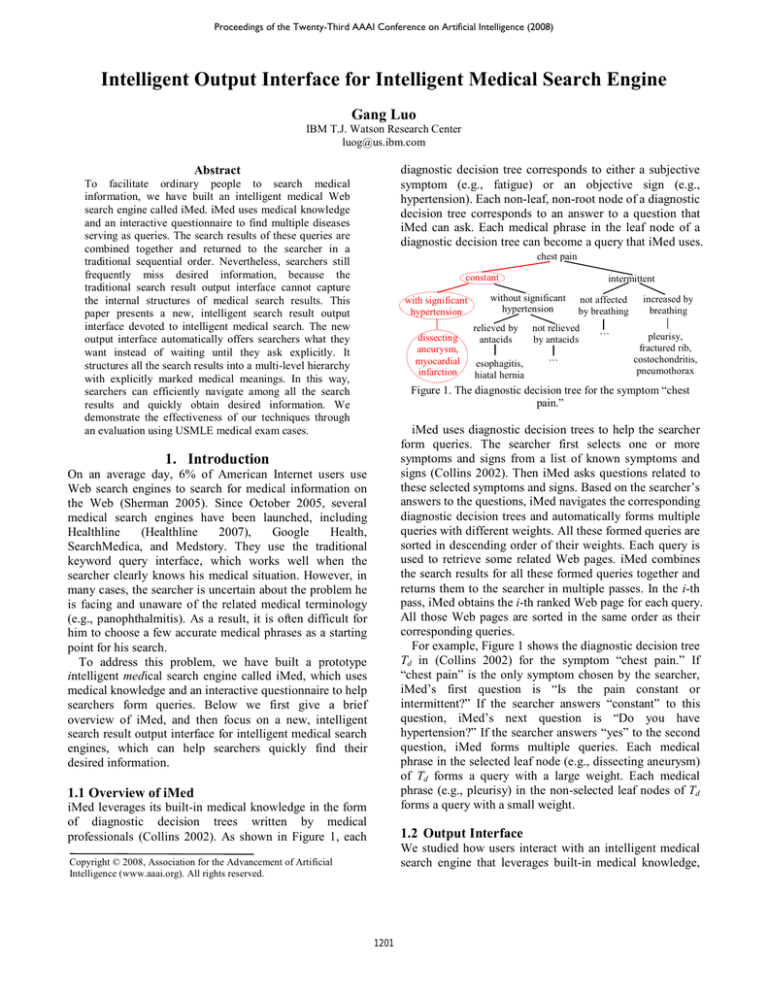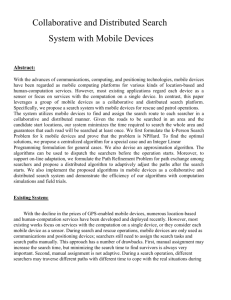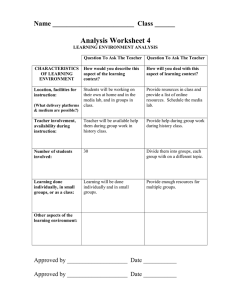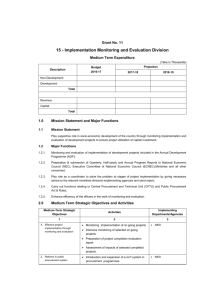
Proceedings of the Twenty-Third AAAI Conference on Artificial Intelligence (2008)
Intelligent Output Interface for Intelligent Medical Search Engine
Gang Luo
IBM T.J. Watson Research Center
luog@us.ibm.com
diagnostic decision tree corresponds to either a subjective
symptom (e.g., fatigue) or an objective sign (e.g.,
hypertension). Each non-leaf, non-root node of a diagnostic
decision tree corresponds to an answer to a question that
iMed can ask. Each medical phrase in the leaf node of a
diagnostic decision tree can become a query that iMed uses.
Abstract
To facilitate ordinary people to search medical
information, we have built an intelligent medical Web
search engine called iMed. iMed uses medical knowledge
and an interactive questionnaire to find multiple diseases
serving as queries. The search results of these queries are
combined together and returned to the searcher in a
traditional sequential order. Nevertheless, searchers still
frequently miss desired information, because the
traditional search result output interface cannot capture
the internal structures of medical search results. This
paper presents a new, intelligent search result output
interface devoted to intelligent medical search. The new
output interface automatically offers searchers what they
want instead of waiting until they ask explicitly. It
structures all the search results into a multi-level hierarchy
with explicitly marked medical meanings. In this way,
searchers can efficiently navigate among all the search
results and quickly obtain desired information. We
demonstrate the effectiveness of our techniques through
an evaluation using USMLE medical exam cases.
chest pain
constant
with significant
hypertension
dissecting
aneurysm,
myocardial
infarction
intermittent
without significant
hypertension
relieved by
antacids
esophagitis,
hiatal hernia
not affected
by breathing
not relieved
by antacids
…
…
increased by
breathing
pleurisy,
fractured rib,
costochondritis,
pneumothorax
Figure 1. The diagnostic decision tree for the symptom “chest
pain.”
iMed uses diagnostic decision trees to help the searcher
form queries. The searcher first selects one or more
symptoms and signs from a list of known symptoms and
signs (Collins 2002). Then iMed asks questions related to
these selected symptoms and signs. Based on the searcher’s
answers to the questions, iMed navigates the corresponding
diagnostic decision trees and automatically forms multiple
queries with different weights. All these formed queries are
sorted in descending order of their weights. Each query is
used to retrieve some related Web pages. iMed combines
the search results for all these formed queries together and
returns them to the searcher in multiple passes. In the i-th
pass, iMed obtains the i-th ranked Web page for each query.
All those Web pages are sorted in the same order as their
corresponding queries.
For example, Figure 1 shows the diagnostic decision tree
Td in (Collins 2002) for the symptom “chest pain.” If
“chest pain” is the only symptom chosen by the searcher,
iMed’s first question is “Is the pain constant or
intermittent?” If the searcher answers “constant” to this
question, iMed’s next question is “Do you have
hypertension?” If the searcher answers “yes” to the second
question, iMed forms multiple queries. Each medical
phrase in the selected leaf node (e.g., dissecting aneurysm)
of Td forms a query with a large weight. Each medical
phrase (e.g., pleurisy) in the non-selected leaf nodes of Td
forms a query with a small weight.
1. Introduction
On an average day, 6% of American Internet users use
Web search engines to search for medical information on
the Web (Sherman 2005). Since October 2005, several
medical search engines have been launched, including
Healthline
(Healthline
2007),
Google
Health,
SearchMedica, and Medstory. They use the traditional
keyword query interface, which works well when the
searcher clearly knows his medical situation. However, in
many cases, the searcher is uncertain about the problem he
is facing and unaware of the related medical terminology
(e.g., panophthalmitis). As a result, it is often difficult for
him to choose a few accurate medical phrases as a starting
point for his search.
To address this problem, we have built a prototype
intelligent medical search engine called iMed, which uses
medical knowledge and an interactive questionnaire to help
searchers form queries. Below we first give a brief
overview of iMed, and then focus on a new, intelligent
search result output interface for intelligent medical search
engines, which can help searchers quickly find their
desired information.
1.1 Overview of iMed
iMed leverages its built-in medical knowledge in the form
of diagnostic decision trees written by medical
professionals (Collins 2002). As shown in Figure 1, each
1.2 Output Interface
We studied how users interact with an intelligent medical
search engine that leverages built-in medical knowledge,
Copyright © 2008, Association for the Advancement of Artificial
Intelligence (www.aaai.org). All rights reserved.
1201
We crawled a large number of medical Web pages from
the Internet and evaluated the effectiveness of our
techniques using USMLE Step 2 CS medical exam cases
(Le & Bhushan 2006). The results show that our
techniques significantly improve the quality of search
results as well as searchers’ satisfaction and speed of
finding desired information.
Besides medical search, the general ideas of this paper
could also be applicable to other domain-specific (e.g.,
product) search. Suppose we have a knowledge base for a
particular domain. Based on the criteria (e.g., price)
specified by the searcher, this knowledge base can provide
all those entities (e.g., cameras) satisfying these criteria and
their interesting aspects (e.g., performance, design). Then
an intelligent search engine for that domain can use our
techniques to automatically build a multi-level search
result hierarchy with explicitly marked meanings specific
to that domain.
The rest of the paper is organized as follows. Section 2
describes the new, intelligent output interface. Section 3
evaluates the effectiveness of our techniques using a wide
variety of medical cases. We conclude in Section 4.
and observed significant improvement over general Web
search engines. However, we also observed that searchers
still frequently miss desired information because the
medical search engine uses the traditional search result
output interface, where all the search results are returned to
the searcher in a sequential order. This order cannot reflect
the internal structures and relationships of the returned
search results, as these results are retrieved using different
queries that have explicit medical meanings.
We use an example to illustrate the above point. After
reading a Web page that is about a disease d and returned
by the search engine, the searcher can run into one of the
following three situations. In the first situation, the
searcher guesses that d can be related to his medical
condition but he is not fairly sure. In this case, the searcher
prefers to read another Web page about d to either
disapprove or confirm his conjecture. In the second
situation, the searcher is convinced that d matches well
with his medical condition. In this case, he often prefers to
read more Web pages about certain aspects of d, e.g.,
treatment, test. In the third situation, the searcher is
convinced that d does not match with his medical condition.
In this case, he prefers to skip all the remaining returned
Web pages about d. The traditional sequential order
presentation of search results cannot well serve these three
situations simultaneously.
2. A New Output Interface
2.1 Why Users Perform Medical Search
To gain insight into searchers’ requirements on the output
interface of intelligent medical search engines, we need to
first understand why many Internet users prefer to perform
medical search before visiting their doctors. There are
several such reasons.
First, in some areas where the population is relatively
sparse, doctors are often inexperienced because they rarely
have the opportunity to encounter various kinds of diseases.
If a patient has a rough idea about the diseases that may
cause his problem before visiting his doctor, he can
provide reminders to his doctor to avoid missing
potentially relevant diagnoses or tests (Fox & Fallows
2003).
Second, many doctors have relationships with certain
drug, medical equipment, or physical therapy companies
and tend to prescribe to patients those companies’ products
or services. If a patient knows the treatment options in
advance, he can suggest to his doctor his preferred
alternative (e.g., inexpensive) treatment options.
Third, doctors are required to talk with patients in plain
English and to explain medical jargons immediately after
they are mentioned in the conversation (Le & Bhushan
2006). Nevertheless, patients can still have difficulty in
understanding doctors due to unfamiliarity with some of
the plain English words that are frequently used by doctors
but seldom appear in daily conversations, e.g., organ
names. This is especially true for both non-native English
speakers and people with low education background.
Performing medical search and reading related medical
information in advance can help patients overcome this
vocabulary obstacle.
1.3 Our Solutions
One idea to address the above problem is to structure all
the search results into a multi-level hierarchy that has
explicitly marked medical meanings. More specifically, all
the search results are organized into multiple categories
according to their topics (e.g., disease names). Within each
category, the corresponding search results are further
divided into multiple sub-categories according to their
aspects (e.g., symptom, diagnosis, treatment).
This hierarchical search result output interface is
intelligent in the sense that it automatically offers searchers
what they want instead of waiting until they ask explicitly.
Ordinary searchers often do not remember or know all the
information they want in the unfamiliar medical domain,
but they usually can tell what they want if they can see
such information. The intelligence of the output interface is
possible because the medical domain is a closed one. In
that domain, we have domain-specific medical knowledge
and searchers’ desired (sub-)categories are generally
known in advance. Using this hierarchy, searchers can
efficiently navigate among the search results and quickly
obtain desired information. An automatic query formation
method is used to construct this hierarchy.
In the traditional information retrieval literature, queries
are inputted by searchers and the focus is on retrieving
search results using better retrieval models. In contrast, the
focus of this work is on automatically forming proper
queries to obtain desired search results and effectively
organizing these search results.
1202
first level
Fourth, to facilitate diagnosis and treatment, patients
need to answer doctors’ questions and often have their own
questions to ask doctors. If a patient has completely no idea
about what questions to expect during his doctor’s office
visit, he may forget to tell his doctor some important
information in a limited amount of time. Also, if a patient
is unfamiliar with the related medical information, he may
not know the appropriate questions to ask his doctor.
Performing medical search and reading related medical
information in advance can prepare patients for questions.
topic 1
second level
aspect 1
third level
page 1
page 2
…
aspect 2
page 1
page 2
…
…
topic 2
…
aspect 1
page 1
page 2
…
aspect 2
page 1
page 2
…
…
Figure 2. The new output interface’s hierarchical structure.
2.2 Requirements on the Output Interface
From the above description, we can see that ordinary
Internet users usually perform medical search to serve
multiple purposes concurrently. To achieve these purposes,
medical information searchers prefer an intelligent medical
search engine to return as complete search results as
possible. More specifically, searchers would like to
simultaneously see various topics (e.g., disease names) that
are potentially relevant to their medical situations. For each
such topic, searchers would like to simultaneously see all
kinds of aspects (e.g., symptom, diagnosis, treatment) of it.
Most medical information searchers neither have much
medical background nor are proficient computer users. For
a potentially relevant topic, it is difficult for these searchers
to list completely all their desired aspects and the
corresponding keywords. Moreover, even if a searcher
knows all his desired aspects and the corresponding
keywords, it is troublesome for him to form multiple
queries, one for each aspect, and use them to retrieve
related information. Fortunately, in the medical domain,
searchers’ desired aspects of a topic are generally known in
advance. For example, if the topic is about a disease, these
aspects would include symptom, diagnosis, treatment, and
prevention. To provide the greatest convenience to
searchers, an intelligent medical search engine should
automatically and concurrently retrieve related information
for all the potentially relevant topics and their
corresponding aspects. The search engine’s output
interface needs to organize these search results in a way
that searchers can simultaneously see all the topics and
aspects, quickly identify the important contents, easily
navigate among those related search results, and freely
make choices about which topics and aspects to view or
skip.
2.3.1 Overview of the Hierarchy. We first give an
overview of the hierarchical structure of the new output
interface. At the first level of the hierarchy, all the search
results are organized into multiple categories according to
their topics (e.g., disease names). At the second level,
within each category, the corresponding search results are
further divided into multiple sub-categories according to
their aspects (e.g., symptom, diagnosis, treatment). For
each aspect of a topic, the retrieved Web pages are listed at
the third level.
To expedite the speed that searchers find their desired
information, medical meanings are explicitly marked at
each level of the hierarchy. Also, overview Web pages are
provided at the top two levels of the hierarchy. More
specifically, at the first level of the hierarchy, topics are
marked. For each such topic, an overview Web page is
provided to help the searcher determine whether this topic
is related to his medical situation. Similarly, at the second
level, aspects are marked. For each such aspect of a topic,
an overview Web page is provided to help the searcher
determine whether this aspect is related to his medical
situation. In many cases, searchers can quickly obtain their
desired information directly from the overview Web pages
at either the first level or the second level. Also, if
searchers think that certain topics or aspects are irrelevant
to their medical situations, they can completely skip the
corresponding categories or sub-categories. In other cases,
searchers need to reach the third level to obtain more
detailed information.
iMed uses the diagnostic decision trees described in
(Collins 2002) to find topics related to the searcher’s
medical situation. There, for each symptom or sign, the
medical phrases in the leaf nodes of the corresponding
diagnostic decision tree are disease names. Consequently,
the topics mentioned at the first level of the new output
interface currently cover only diseases. In the future, if
other contents (e.g., exams) are added into these diagnostic
decision trees, the topics and aspects mentioned in the new
output interface need to be expanded accordingly.
2.3 Format of the New Output Interface
iMed uses diagnostic decision trees to find those topics that
are potentially relevant to the searcher’s medical situation.
After obtaining the search results on those topics, iMed
structures these search results into a three-level hierarchy
that has explicitly marked medical meanings to fulfill the
requirements mentioned in Section 2.2. This is shown in
Figure 2.
2.3.2 First Level of the Hierarchy. Next, we present the
details of the hierarchical structure of the new output
interface. Figure 3 shows the format of the first level of
1203
sets of aspects. For example, some diseases are not treated
with surgery and hence do not need the surgery element.
As another example, certain diseases have their own
unique aspects and need the corresponding aspect elements,
e.g., diabetes patients need special diet recipes. We leave it
as an interesting area for future work to construct the
aspect database for all the diseases.) iMed suggests to the
searcher a few medical phrases related to T and lists them
on the right side of Pa. These medical phrases are extracted
from the MeSH ontology. On the bottom right corner of Pa
there is a navigation button entitled “All found diseases.” If
the searcher clicks this button, he will return to the topic
page that is at the first level of the new output interface and
contains the topic element ET of T.
As shown in Figure 6, each aspect element EA, T
this hierarchy. The new output interface organizes all
found topics into one or more topic pages. Each topic page
contains ten topic elements. To help a searcher quickly
digest search results and refine his inputs (Healthline 2007;
Luo et al. 2007), iMed suggests to him a few medical
phrases related to his medical situation and lists them on
the right side of each topic page. These medical phrases are
extracted from the Medical Subject Headings (MeSH)
ontology (MeSH 2007). MeSH is a standard vocabulary
edited by the National Library of Medicine and widely
used for indexing and cataloging biomedical and healthrelated documents.
Topic element 1 Medical
Topic element 2 phrases
…
suggested for
Topic element 10 all found topics
Topic Page
1 2 3 4 5 ► Next
Figure 3. The high-level
format of the first level of
the new output interface.
corresponds to a different aspect A (e.g., symptom and sign)
of topic T. The left side of EA, T contains the information of
an overview Web page PAo, T of A of T, including the title,
As shown in Figure 4, each topic element ET in a topic
page corresponds to a different topic T (e.g., dissecting
aneurysm). The left side of ET contains the information of
an overview Web page PTo of T, including the title, the
snippet (i.e., some words extracted from PTo ), and the URL
the snippet, and the URL of PAo, T . The searcher can view
PAo, T by clicking its title. On the right side of EA, T , there is
a button entitled “More about A of T.” If the searcher clicks
this button, he will reach a result page at the third level of
the new output interface and see more information about A
of T.
of PTo . The searcher can view PTo by clicking its title. On
the right side of ET, there is a button entitled “More about
T.” If the searcher clicks this button, he will reach an
aspect page at the second level of the new output interface
and see more information about T.
Title
Snippet
URL
2.3.3
More about
dissecting aneurysm
Title
More about the symptoms and
Snippet
signs of dissecting aneurysm
URL
Figure 4. An example of the
topic element format at the first
level of the new output interface.
2.3.4 Third Level of the Hierarchy. Figure 7 shows the
format of the third level of the new output interface. All the
Web pages retrieved for aspect A of topic T are organized
into one or more result pages. A of T is listed at the top of
each result page in italics. Each result page contains ten
Web page elements. iMed suggests to the searcher a few
medical phrases related to A of T and lists them on the right
side of each result page. These medical phrases are
extracted from the MeSH ontology. Two navigation
buttons appear on the bottom right corner of each result
page. If the searcher clicks the button entitled “All found
diseases,” he will return to the topic page that is at the first
level of the new output interface and contains the topic
element ET of T. If the searcher clicks the other button
entitled “All aspects of T,” he will return to the aspect page
of T at the second level of the new output interface.
Second Level of the Hierarchy
dissecting aneurysm
Symptom and sign element
Diagnosis, exam, and test element
Treatment element
Cause and trigger element
Risk factor element
Complication element
Medication element
Surgery element
Prognosis (expectation) element
Rehabilitation, recovery, self-care, and home treatment element
Prevention element
Complementary and alternative medicine element
Resource, support, living with, and management element
General information element
Other information element
Figure 6. An example of
the aspect element format
at the second level of the
new output interface.
medical
phrases
suggested
for the
topic
All
found
diseases
Figure 5. The high-level format of the second level of the new
output interface.
symptoms and signs of dissecting aneurysm
Web page element 1
Medical phrases
Web page element 2
suggested for the
…
aspect of the topic
Web page element 10
Result Page
All aspects of
All found
1 2 3 4 5 6 7 8 9 10 ► Next
dissecting aneurysm
diseases
Figure 5 shows the format of the second level of the new
output interface. At the top of the aspect page Pa, the
corresponding topic T is listed in italics. All the aspects of
T are listed on Pa in the form of aspect elements, e.g., the
symptom and sign element. (At present, iMed uses the
same set of aspect elements for all the diseases.
Nevertheless, in theory, different diseases can have various
Figure 7. The high-level format of the third level of the new
output interface.
1204
information on various topics such as symptoms, diseases,
drugs, and treatments.
We used USMLE Step 2 CS (Clinical Skills) medical
exam cases (Le & Bhushan 2006). USMLE stands for the
United States Medical Licensing Examination. Physicians
have to pass this exam to obtain their licenses for
practicing medicine. The exam cases used in USMLE Step
2 CS cover the typical cases encountered in daily medical
practice. Each exam case has a summary that includes a
several-page-long, detailed description of the patient’s
situation. One such medical case is shown in Figure 9. For
each medical case, a few most likely candidate diagnoses
are available, while making the final diagnosis among
these candidate diagnoses usually requires special medical
test results that are not included in the USMLE Step 2 CS
Exam.
As shown in Figure 8, each Web page element EP
corresponds to a different Web page P retrieved for aspect
A of topic T. EP contains the title, the snippet, and the URL
of P. The searcher can view P by clicking its title.
Title
Snippet
URL
Figure 8. The Web page element format at the
third level of the new output interface.
2.4 Discussions
The hierarchical structure of the new output interface
currently has three levels while more levels can be easily
added at appropriate places. For example, at the third level
of the new output interface corresponding to the
medication aspect of a disease T, we can include a button
entitled “All related drugs.” If the searcher clicks this
button, iMed will create an additional three-level search
result hierarchy for all the drugs used to treat T. The drug
names are obtained from the Merck Manual (Merck 2007),
the best-selling medical reference in the world. Those
additional three levels correspond to drugs, aspects (e.g.,
dosage, side effect, precaution, and interaction), and Web
pages, respectively.
The patient is a 46 years old male complaining chest pain. Chest
pain started 40 minutes before the patient presented to the
hospital. The pain woke the patient from sleep at 5 a.m. with a
steady 7/10 pressure sensation in the middle of his chest that
radiated to the left arm and the neck. Nothing makes it worse or
better. Nausea, sweating, and dyspnea are also present. Similar
episodes have occurred during the past 3 months, 2-3
times/week ...
Figure 9. An example USMLE Step 2 CS medical exam case.
2.5 Automatic Query Formation
The search result hierarchy is constructed using an
automatic query formation method. We give a brief
overview of that method here. The reader can find the
details of that method in (Luo 2008). Our main observation
is that the medical domain is a closed one. In the desired
search result hierarchy, we can know the keywords for all
the topics and their corresponding aspects. As a result, for
each part of the search result hierarchy, we can use a
different, specifically formed query to obtain the
corresponding search result Web pages. When forming
these queries automatically, we use domain-specific
medical knowledge and consider the different roles that
various levels play in the search result hierarchy. This can
expedite the speed that searchers find their desired
information. The resulting search result hierarchy fulfills
all the requirements mentioned in Section 2.2.
To reduce the load on iMed and to maximize the speed
that searchers can see iMed’s outputs, iMed constructs the
search result hierarchy one part at a time. Each part of the
hierarchy is generated only at the time that it is needed.
We randomly selected 30 medical cases. Since USMLE
covers almost every aspect of medical practice, our random
samples have a broad coverage of medical topics. Ten
colleagues served as assessors and independently evaluated
iMed. None of them has formal medical training. In iMed,
we compared the traditional techniques with the new
techniques proposed in this paper. For each medical case,
we randomly divided all ten users into two groups of the
same size. When performing search, one group used iMed
implemented with the traditional techniques while the other
group used iMed implemented with the new techniques.
In our experiments, a user has up to 60 minutes to
perform iterative search for each medical case. At the end
of the search process, the user can list up to three diseases
that he thinks best match the medical case’s situation
description. If any of these diseases is among the most
likely candidate diagnoses accompanying the data set, the
search is considered successful. We allow users to search
for a relatively long time, because medical information
searchers care about their health and often spend hours on
searching. We allow users to list multiple diseases as their
findings, because even doctors sometimes cannot make
precise diagnosis without lab test results.
Similar to the TREC interactive track (TREC 2007), we
use two sets of measures as the performance metrics for
intelligent medical search engines: one set is objective
while the other set is subjective. The objective performance
measures include the success rate, the number of search
iterations, the number of search result Web pages viewed,
and the time spent on the search process. The subjective
3. Experimental Results
We conducted experiments with various medical cases to
demonstrate the effectiveness of our techniques. iMed is a
vertical search engine that crawls Web pages from a few
selected, high-quality medical Web sites instead of all the
Web sites. In our experiments, we crawled 22GB of Web
pages from WebMD (WebMD 2007), Healthline
(Healthline 2007), and Merck (Merck 2007), three of the
most popular medical Web sites. These Web sites cover the
entire medical domain fairly comprehensively and include
1205
marked medical meanings and organizes together all the
search results on the same topic or aspect so that users can
find them easily. Consequently, users feel that the new
output interface is easier to use than the traditional output
interface. Overall, the new techniques improve user
satisfaction as they help produce more useful search results.
These differences are statistically significant.
performance measures include the users’ perceptions of
ease of using the system, ease of understanding the system,
usefulness of the search results, and overall satisfaction
with the system. All these subjective performance
measures are on a 7-point scale, with 1=low and 7=high
(TREC 2007). They were obtained from a brief
questionnaire that users filled out after using the systems.
For each objective or subjective performance measure, we
average it over all the 30 medical cases and all the users,
and report both its mean and its standard deviation when
appropriate. We used ANOVA (Bickel & Doksum 2001)
as the significance test. Our experiments were performed
on a computer with two 3GHz processors, 2GB memory,
and one 111GB disk.
4. Conclusion
This paper presents an intelligent search result output
interface for intelligent medical search engines, where all
the search results are structured into a multi-level hierarchy
that has explicitly marked medical meanings. Our
techniques take into account the unique requirements of
medical search and utilize domain-specific medical
knowledge. Our experiments with a wide variety of
medical cases and an implementation in iMed demonstrate
that our techniques significantly improves the quality of
search results and the speed that searchers find desired
information.
Table 1. Objective performance measures (* means significant at
<0.05 level).
mean (standard
deviation)
success rate
number of iterations
number of search result
Web pages viewed
time (minutes)
traditional
techniques
29% (12%)
3.7 (1.1)
14.7 (6.3)
39 (11)
new
techniques
35%* (10%)
2.9* (1)
11.3* (5.8)
Acknowledgements
We thank Haiyan Chen, Chunqiang Tang, Selena Thomas,
Ying-li Tian, and Rong Yan for helpful discussions.
30* (10)
Our overall results are as follows. The new techniques
are efficient. For all the 30 medical cases, the average time
taken by the new techniques to generate each part of the
search result hierarchy is less than two seconds. The new
techniques are much more effective than the traditional
techniques in finding the correct diagnosis, where most of
the user’s time is spent on reading the search result Web
pages. The objective performance measures in Table 1
show that the new techniques help the user find results in
fewer iterations, view fewer search result Web pages,
spend less time on the search process, and achieve a higher
success rate. All these differences are statistically
significant.
References
Bickel, P.J., and Doksum, K.A. 2001. Mathematical
Statistics: Basic Ideas and Selected Topics, Vol. 1. Prentice
Hall.
Collins, R.D. 2002. Algorithmic Diagnosis of Symptoms
and Signs: Cost-Effective Approach. Lippincott Williams
& Wilkins.
Fox, S., and Fallows, D. 2003. Internet health resources:
Health searches and email have become more
commonplace, but there is room for improvement in
searches and overall Internet access. www.pewinternet.org/
pdfs/PIP_Health_Report_July_2003.pdf.
Healthline homepage 2007. www.healthline.com.
Le, T., and Bhushan, V. 2006. First Aid for the USMLE
Step 2 CS (Clinical Skills Exam). McGraw-Hill.
Luo, G. 2008. iMed: an intelligent medical Web search
engine. Available at pages.cs.wisc.edu/~gangluo/imed.pdf.
Luo, G.; Tang, C.; and Yang H. et al. 2007. MedSearch: A
specialized search engine for medical information.
WWW’07: 1175-1176.
MeSH homepage 2007. www.nlm.nih.gov/mesh/
meshhome.html.
Merck Manual Home Edition homepage 2007.
www.merck.com/mmhe/index.html.
Sherman, C. 2005. Curing Medical Information Disorder.
searchenginewatch.com/showPage.html?page=3556491.
TREC interactive track homepage 2007. trec.nist.gov/
data/interactive.html.
WebMD homepage 2007. www.webmd.com.
Table 2. Subjective performance measures (* means significant at
<0.05 level).
mean (standard
deviation)
ease of using
ease of understanding
usefulness
satisfaction
traditional
techniques
4.9 (1.1)
5.8 (1.0)
5.2 (0.9)
5.1 (1.0)
new
techniques
5.7* (1.2)
5.6 (1.2)
6* (0.9)
5.8* (0.9)
Table 2 shows the subjective performance measures. As
it takes time to become accustomed to navigating the
search result hierarchy in the new output interface, users
consider the traditional output interface slightly easier to
understand than the new output interface, while the
difference is not statistically significant. Nevertheless, once
users understand the new output interface, they can use it
without difficulty. The new output interface has explicitly
1206






